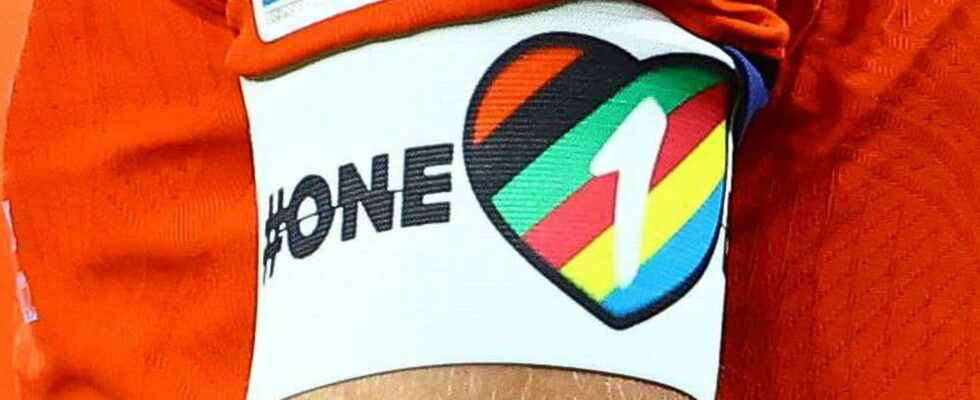During the World Cup in Qatar, football players were banned by FIFA from wearing the “One Love” armband. Can this become a symbol of protest during the World Cup?
[Mis à jour le 22 novembre 2022 à 22h23] The “One Love” armband soap opera may not be over. The turmoil caused by this piece of fabric, which FIFA has banned from competition for this 2022 World Cup, could well generate other tremors off the field. On the occasion of the first match of the Blues during the competition, Tuesday, November 22, no player from the France team wore the armband. The only highlight: in the stands, Helle Thorning-Schmidt, Prime Minister of Denmark from 2011 to 2015, wore rainbow sleeves. The day before, the English players, who could not wear the armband, knelt down in protest. Indeed, FIFA threatened to sanction players with a card if they wore LGBT colors. Tuesday, November 22, the German football federation expressed in a press release “its disappointment” and “its indignation”. “We were subjected to extreme blackmail in which we thought we had to take this decision even if we did not want to take it,” protested the players of the German team. To fully understand what it is about and why Qatar may fear that it will be more and more media, here is what to remember.
1/ The teams of the European nations wanted to wear the One Love armband
England, Belgium, Wales, Denmark, Germany, the Netherlands and Switzerland signaled several weeks ago their intention to send a message of defense of human rights to the field, while Qatar is singled out by many NGOs for the discrimination suffered by women and homosexuals in the country. Remember that homosexuality is illegal in Qatar, prison sentences are provided for facts relating to the simple fact of claiming one’s homosexuality, harsher in the case where the offender is of Muslim faith.
The federations of the said European nations were therefore ready to send a message, by having certain players wear a “One Love” armband, in particular with rainbow colors reminiscent of those of the LGBT community. The initiative was launched by the federation of the Netherlands, then by that of Germany, quickly involving the other major federations of the European continent. The armband is made up of colors that are not those of the LGBT flag, to open the message to the fight against all forms of discrimination, whether related to skin color or sexuality.
But FIFA considered this to be a political position and a moral criticism of the country which organizes the World Cup. It has thus brandished the threat of financial sanctions with the federations which would persist. Note that France had announced that it did not support the initiative, considering that the French team was there to “play football”.
2/ The federations resist… then abandon the armband
FIFA’s threats have turned into threats of sporting sanctions: players wearing such an armband are immediately sanctioned with a yellow card, for “non-compliance with the instructions on authorized outfits”. In such a competition, this constitutes a real handicap. The European federations have therefore decided to comply with FIFA’s requirements. “We were prepared to pay applicable fines for breaking equipment rules and were very committed to this armband. But we cannot put our players in the situation where they could be warned or even have to leave the field”, indicated the federations concerned in a joint statement. FIFA has nevertheless made it known that official armbands, provided by the body to national teams, on which the message “No to discrimination” would be inscribed, could be worn during the quarter-finals of the World Cup.
3/ The armband appears on television… and on official grounds
The One Love armband, banned and banned, has since been considered as an object embodying a de facto challenge to FIFA and Qatar’s anti-LGBT legislation. It is the subject of press articles in many countries of the world, has been mentioned in many television news in Europe since Monday, November 21.
During the England-Iran match on Monday, former international player Alex Scott wore it on his arm in front of the pitch. The former Arsenal side was on the lawn to provide sports lighting for television, on the BBC channel, which employs her as a consultant.
This initiative was widely noticed around the world, given the media weight of the British channel. The former player publicly defended her gesture: “Four years ago I was the first female expert for the BBC at the World Cup. You think of how far we have come in the last four years. […] Today we talk about migrant workers, we talk about the LGBT community and women’s rights. […] Hopefully at the next World Cup we never have to have those topics of conversation again.”
It is not excluded that the example of Alex Scott will be taken up by fellow consultants, from several media, during this 2022 World Cup. FIFA cannot prohibit the wearing of the armband off the field; however, the World Cup does not stop at the green square. Does this mean that the “One Love” armband can impose itself as the great symbol of this edition?
